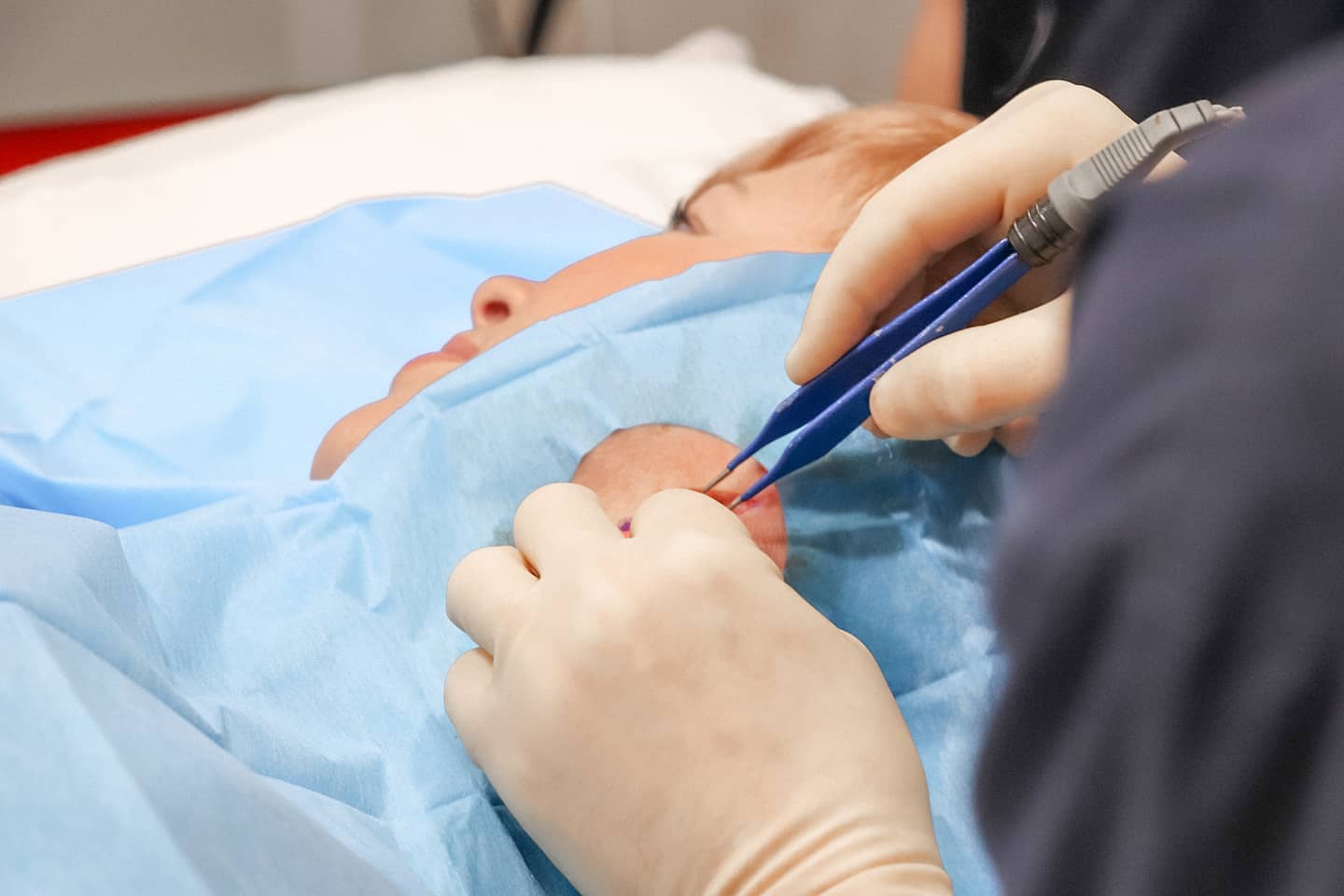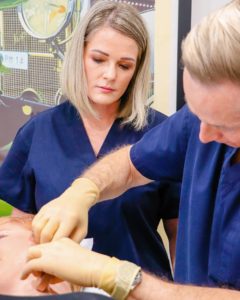Cyst Removal in London UK by Mr Mark Gittos Plastic Surgeon
A Cyst is a sac or capsule-like structure containing fluid or semi-solid material that can develop on your skin or inside the body. Cysts are most frequently found in the skin, ovaries, breasts, or kidneys and most of these are not dangerous.
There are two common types of cysts that grow in or underneath the skin, these are sebaceous cysts and epidermoid cysts. Both the cysts appear as flesh-colored or whitish-yellow smooth lumps.
The epidermoid cysts are formed when the skin cells on the surface move inwards and multiply forming the wall of the cyst, which is filled by a soft, yellowish substance, called keratin.
Sebaceous cysts are formed inside the sebaceous gland, which is a minute exocrine gland in the skin that opens into a hair follicle to secrete an oily or waxy material called the sebum. Such cysts are usually formed when the secretion of the sebaceous gland is trapped, forming a pouch filled with sebum. These affect at least 20% of the adult population and can range in size from a few millimeters to 5 centimeters.
They are usually not painful or tender until they burst, become inflamed, damaged, or infected.
Sebaceous cysts are non-cancerous growths that often appear on the scalp, face, ears, trunk, back, or groin area. You can get your cyst if it turns painful or for cosmetic reasons. Cyst removal also known as a cyst excision is a relatively simple and fast procedure.
What causes a Cyst? – Cyst Etiology
Sebaceous glands are minute exocrine glands present on the skin, which opens into the hair follicle. It lubricates the hair and skin releasing an oily or waxy substance called sebum.
Sebaceous cysts are formed due to any damage of these sebaceous glands or blockage of its duct, which is the passage from where the sebum is released into the hair follicle. This usually occurs due to a trauma to the area. Trauma can be a minor scratch or injury, a skin condition like acne, or a surgical wound.
As the growth of these cysts are gradual, it is highly likely that the initial trauma may have happened weeks or months before the cyst formation.
Apart from trauma to the area, some other causes may include:
- Disfigured or deformed duct
- Damage to the cells during a surgery
- Due to genetic conditions
- Gardner’s syndrome: A genetic condition that is linked with skin cysts and other types of growths.
- Basal cell nevus syndrome
Symptoms of a Cyst
Smaller cysts are usually not painful, but large cysts can be quite uncomfortable and extremely painful. Growth of large cysts on the face and neck can cause significant pain and pressure.
This type of cyst is typically filled with white flakes of keratin, which is also a key element that makes up your skin and nails. Most cysts are soft to the touch.
A sebaceous cyst is thought to be possibly malignant if it has the following characteristics:
- Larger than five centimeters in diameter
- Reoccurs promptly after removal
- Signs of infection, such as redness, pus drainage, or pain
Diagnosis of a Cyst and checking for Cancer
Diagnosis of a sebaceous cyst can be done through a simple physical examination. If your cyst is suspected to be cancerous, additional tests are recommended to rule out the possibility of cancer. In order to surgically remove the cyst, the following tests must be performed :
- CT scans: This helps find the best route for surgery and to spot abnormalities
- Ultrasounds: Helps in the identification of the contents of the cyst
- Punch biopsy: Involves the removal of a small amount of tissue from the cyst, which is examined in the laboratory for possible signs of cancer
Treatment Options for sebaceous Cyst
Most sebaceous cysts do not need treatment as they usually are harmless, and it is best not to interfere with it however, it must be kept clean.
Trying to remove or treat a cyst by picking, rubbing, or squeezing, it can further worsen the situation. It can cause infections, pain, and tenderness. Therefore, seek professional help if the cyst is causing discomfort because of an infection, or it is in a prominent location, or it hampers in your day-to-day activity surgical removal is suggested. Apart from these reasons, cysts are also removed for cosmetic reasons.
Complete treatment of a cyst can be done only by draining it or by surgically removing it. It is vital to ensure complete removal as it negates any chances of reoccurrence.
Any one of the following methods may be used to remove your cyst:
- Conventional wide excision: This method ensures complete removal of the cyst but will likely leave a scar. The process involves the following steps:
- A local anesthetic will be applied to numb the area
- Antiseptic swabs will be applied to prevent and stop th
- e spread of the infection
- A blade and other instruments will be used to completely excise the cyst
- Gauzes will then be packed into the wound and can be removed after a day or two
- In case of large cysts, sutures may be required
- Minimal excision: After the application of a local anesthetic on the site, a small incision will be made through either a blade or laser and the contents of the cyst will be drained by gently squeezing. This method causes the least scarring but carries a high risk of reoccurrence of the cyst.
The incision will close naturally after a week of the procedure. The scarring associated with this process is minimal and there is also no risk of reoccurrence of the cyst.
Recovery following the surgery is usually rapid except in the case of a sizable cyst, where you might have to rest for a day before joining work. In other cases, you will be able to return home immediately and resume regular activities straight away.
You will be given an antibiotic ointment to prevent infection, which you should continue to use until the healing process is complete. In case of scarring, a scar cream will also be prescribed to you.
In case a cyst bursts or there is an infection under the skin, it will be necessary to lance and drain it and a full course of antibiotics will be prescribed to you.
Risks of the Cyst Removal surgery
As with all surgical procedures, cyst excision may be associated with certain complications that include:
- Bleeding
- Infection
- Nerve damage
- Possible scarring
- Pain
- Inflammation
- Possible recurrence
Recovery after Cyst Removal
Aftercare instructions will be given to you that may include the following recommendations:
- Cover the wound with a dry bandage and change the bandage as advised as there may be some drainage for a few days.
- If a gauge is used to cover the wound, you may need to return to the doctor’s office to remove it.
- If oral antibiotics are prescribed, complete the dose.
- Antibiotic creams or ointments should be applied as advised.
- Take pain medications as prescribed.
Risks of trying to remove a cyst at home
Trying to remove a cyst yourself can be risky due to the following reasons:
- If it’s not a cyst, you could worsen the situation.
- Popping or bursting a cyst with an unsterilized sharp object can result in infection and spreading it further.
- You can harm nearby tissues.
- If you don’t completely remove the cyst, it can become infected or can reoccur.
Removal of Infected cysts
A cyst can become infected when trying to pop it by hands or bursting it with an unsterilized sharp object. It may look red due to inflammation or can even have a whitish appearance due to the presence of pus.
If you suspect any infections you should seek professional help immediately. They can prescribe antibiotic medication.
You can try to manage an infected cyst by:
- Applying a warm compress around the area
- Keeping it clean
- Not applying cosmetic products to cover it
Frequently Asked Questions about a Cyst & Cyst Removal
Is a cyst a tumor?
- No, not all cysts are tumors. Sebaceous cysts are non-cancerous growths that often appear on the scalp, face, ears, trunk, back, or groin area. A sebaceous cyst can be considered as a tumor if it shows the following characteristics:
- Larger than five centimeters in diameter
- Reoccurs promptly after removal
- Signs of infection, such as redness, pus drainage, or pain
What is inside a cyst?
- Cysts usually contain fluid or semi-solid material. A sebaceous cyst contains an oily or waxy substance known as sebum, while an epidermoid cyst has a soft, yellowish substance, called keratin.
Should I drain my cyst at home?
- You should never try to drain a cyst yourself at home as it can be risky due to the following reasons:
- If it’s not a cyst, you could worsen the situation.
- Popping or bursting a cyst with an unsterilized sharp object can result in infection and spreading it further.
- You can harm nearby tissues.
- If you don’t completely remove the cyst, it can become infected or can reoccur.
- Always seek professional help in such cases.
Should I have my sebaceous cyst removed?
- Most sebaceous cysts do not need treatment as they usually are harmless. But if the cyst is causing you discomfort because it is infected, it is in a prominent location, it hampers in your day-to-day activity, or due to cosmetic reasons, you should remove the cyst.
Do cysts grow fast?
- No, sebaceous cysts grow gradually over time. The trauma may likely have happened weeks or months before you begin to notice the cyst.
What happens when a cyst pops?
- A cyst can become infected when popped by hands or bursting with an unsterilized sharp object. It may look red due to inflammation or can even have a whitish appearance due to the presence of pus. If you suspect any infections, you should seek professional help immediately.
How long do you keep a warm compress on a cyst?
- You can apply a warm compress on a cyst for 10 to 15 minutes, 3-5 times a day as this is thought to help ease inflammation and encourage drainage.
What is the risk associated with cyst removal?
- Cyst removal may be associated with certain complications that include:
- Bleeding
- Infection
- Nerve damage
- Possible scarring
- Pain
- Inflammation
- Possible reoccurrence
Will cyst removal leave a scar?
- Scarring is an inevitable part of any surgical process. There are three methods of cyst removal and each has a different level of scarring. Conventional wide excision method will leave the biggest scar out of the three. While the minimal excision method and removal of the cyst through laser punch and cyst wall with minimal postponed excision method will leave with little unnoticeable scarring. In a cyst removal surgery, it is worth remembering that the cyst size will determine by the size of the scar.
What causes sebaceous cyst?
- Sebaceous cysts are formed due to damage of the sebaceous glands or blockage of its duct. It usually occurs due to a trauma to the area, which can be a minor scratch or injury, a skin condition like acne, or a surgical wound. Some other causes may include:
- Disfigured or deformed duct
- Damage to the cells during a surgery
- Due to genetic conditions
- Gardner’s syndrome
- Basal cell nevus syndrome
What are signs of a sebaceous cyst?
- Small sebaceous cysts are usually not painful, but large cysts can be quite uncomfortable and extremely painful. If a large cyst develops on the face or neck, it can cause considerable pain and pressure.
Are cysts hard?
- No, most cysts are soft to the touch. Avoid touching the cyst as it might burst with minimal contact.
Is cyst removal painful?
- You won’t feel any pain during the procedure as a local anesthetic will be applied at the site.
Can you get rid of a cyst without surgery?
- Getting rid of the cyst completely without surgery is not possible.
How do you get rid of a cyst under your skin?
- You can get rid of a cyst under your skin through any of the following three surgical methods:
- Conventional wide excision technique
- Minimal excision technique or
- Removal of the cyst through Laser punch and cyst wall with a minimal postponed excision technique

Further Reading – Medical References on Cyst Removal
- Sebaceous cyst: Removal, infections, and treatment (medicalnewstoday.com)
- A New Procedure for Treating a Sebaceous Cyst: Removal of the Cyst Content with a Laser Punch and the Cyst Wall with a Minimal Postponed Excision (nih.gov)
- Cysts (Overview) – Harvard Health


